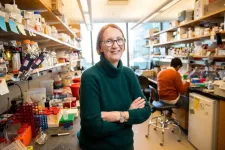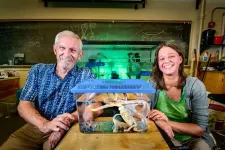By Benjamin Boettner
(BOSTON) — In sciences, disruptive research that is breaking new ground often raises new and not-yet-explored ethical questions. Although new scientific breakthroughs can have the power to change how we understand and live in the world, the ethical implications of technologies that will emerge based on these new insights can affect an emerging field’s public acceptance and have moral implications for society at large. They can also impact the process of translating discoveries into real-world products, sometimes requiring new regulation.
Historically, ethicists – who form the branch of philosophy that is concerned with morality and studies of human conduct in relation to the self, others, and the natural world – were only given the opportunity to analyze transformative breakthroughs in the life sciences after-the-fact, when new scientific possibilities already start to impact the real world. This has often prevented the creation of crucial decision moments and course corrections before ethical controversies gained momentum and bioethicists specializing on medical, public health, animal, or environmental ethics were called upon.
“To overcome current limitations, it is crucial that the analysis process be initiated at the earliest stages when fundamental discoveries are made to clearly answer the question of what, for example, newly created biological constructs are. This first analysis is actually an explicitly philosophical one – only when it determines that an ‘ethical threshold’ is reached should a more ethics-focused analysis follow,” said Wyss Institute Collaborative Ethics lead Jeantine Lunshof. “This analysis ensures that an ethical analysis is conducted when it is relevant and useful.”
Lunshof, in her collaborative work with researchers at the Wyss Institute and Harvard Medical School (HMS) over more than 15 years, has advanced a generic model of “Collaborative Ethics.” There is special need for frequent philosophical and ethical reassessment in organizations, such as the Wyss Institute, which develop new breakthrough technologies and translate them at an extremely fast pace. To ensure this is most functional, “The Collaborative Ethics effort is also aligned with the Wyss Institute’s Technology Innovation Funnel, which formalizes the journey of its cutting-edge technologies starting at the ‘Idea Generation’ stage when fundamental discoveries are made and first assessed for their translational potential,” said Lunshof, who holds a Ph.D. and M.A. in Philosophy and Health Law. “But they can be applied to translational research in any academic environment.” Now, Lunshof and Julia Rijssenbeek, a Graduate Student at Wageningen University in the Netherlands who did a Ph.D. internship at the Wyss Institute, have published the Collaborative Ethics model in Nature Methods.
In the Wyss’ Translation Innovation Funnel, potentially life-saving and changing technologies proceed through “Concept Refinement,” “Technology Validation,” “Technology Optimization” and “Commercialization” stages. This path is paralleled by steps the Collaborative Ethics model provides for investigating philosophically and ethically relevant implications and creating further actionable decision points.
For Collaborative Ethics to work effectively, it is essential that the early dialogue between researchers and ethicists continues through all stages of technology development, all the way to the creation of products that can be commercialized. “It doesn’t suffice that a philosopher or an ethicist occasionally reviews a research group’s work as an outsider or audits it for a different department or organization. For a meaningful dialogue to happen, it is essential that they become actual members of project teams to facilitate meaningful reflections during the scientific process instead of when it has been concluded,” said Rijssenbeek. “This immensely facilitates the exchange of thoughts in both directions, philosophical and ethical innovation, as well as decision-making processes that enable responsible research and innovation towards life-changing technologies.”
Lunshof’s philosophical and ethical work at Harvard University began in 2006 in the lab of Wyss Institute Core Faculty member George Church, Ph.D., who at HMS pioneered the decoding and study of genomes, particularly that of the human genome, and the relatively young field of synthetic biology. Church is also the Robert Winthrop Professor of Genetics at HMS. As Church’s collaborator, Lunshof became involved with the Personal Genome Project, which was begun the previous year and aimed to sequence and publicize the complete genomes and medical records of 100,000 volunteers. Subsequently, as a Marie Sklodowska Curie International Fellow, her interest expanded into the new realities of genome engineering, the creation of chimeras from cells stemming from different organisms, and other disruptive scientific advances made in Church’s lab. Her participation helped pave the way toward a more balanced public perception of the research.
Lunshof continued her work by focusing on other “hot topic” ethical areas, some of them closely related to research conceived at the Wyss Institute. She co-led the Brainstorm Project, which was part of the US National Institutes of Health BRAIN initiative neuroethics program, where she helped create an ethically recommendable path forward for neural or “brain organoids” as models for human brain development and brain disease. The Wyss Institute’s CircaVent Project, led by Church, uses brain organoids to model neurological and psychiatric disorders, in the discovery of urgently needed drugs.
Another example of ethically complex technology is “biobots,” tiny computer-designed living organisms with programmed behaviors built from animal or human cells. Developed by Michael Levin’s group at the Wyss Institute and Tufts University in collaboration with roboticists and computer scientists at the University of Vermont, biobots do not fit into any traditional ethical category. They raise important questions regarding their identities and what the researchers’ intentions and goals are. Levin is an Associate Faculty member at the Wyss Institute as well as Distinguished Professor and Vannevar Bush Chair at Tufts University’s Department of Biology.
Lunshof and Rijssenbeek used these and other examples to illustrate how the Collaborative Ethics model has been successfully applied in practice. Being integrated with the research process through four defined steps, it first carries out a “Conceptual Analysis,” by asking the question “what is it?.” – in the case of biobots, are these novel life forms organisms, robots, or machines?
The second step, “Normative Analysis,” marks the transition from general philosophy to ethics and drills into the question of whether certain research raises any ethical concerns.
The model’s third step, “Applied Ethics,” is similar to bioethicist’s role, and applies ethical theories to assess the real-world impact of technology developments like, for example, the use of animals in research, the provenance of human biological specimens, questions of privacy and consent, the benefits and risks of new technologies such as genome editing for patients, and the justification of gain-of-function research that could lead to new antimicrobials but also result in enhanced pathogens. The question of whether a finding that can bring benefits but also carries risks of harm should be published at all to prevent any misuse is also considered here.
Finally, in the “Regulatory Science and Legal Aspects” step, researchers and ethicists guided by the Collaborative Ethics model team up with business development and technology transfer experts to analyze how a technology can be translated into real-world applications by a spin-off or through licensing by industry.
“Because science and technology development are progressing at an ever-higher speed, and are globalizing rapidly, real-time collaboration between researchers and ethicists becomes vital. It enables a learning curve and necessary adjustments in the research process, as well as the development of missing ethical approaches and the revision of ethics positions.” said Lunshof, who was named a Fellow of The Kavli Foundation which supports the advancement of science and the increase of public understanding and support for scientists and their work, earlier this year.
“In their relentless pursuit of urgently needed solutions for patients and the environment, Wyss Institute researchers not only collaborate across disciplines with one another and with industrial partners scientifically, but they also make sure that they evaluate their research from a philosophical and ethical perspective – the Collaborative Ethics model is an invaluable guide to accomplish this,” said Wyss Founding Director Donald Ingber, M.D., Ph.D., who is also the Judah Folkman Professor of Vascular Biology at HMS and Boston Children’s Hospital, and Hansjörg Wyss Professor of Bioinspired Engineering at the Harvard John A. Paulson School of Engineering and Applied Sciences.
PRESS CONTACT
Wyss Institute for Biologically Inspired Engineering at Harvard University
Benjamin Boettner, benjamin.boettner@wyss.harvard.edu
###
The Wyss Institute for Biologically Inspired Engineering at Harvard University (www.wyss.harvard.edu) is a research and development engine for disruptive innovation powered by biologically-inspired engineering with visionary people at its heart. Our mission is to transform healthcare and the environment by developing ground-breaking technologies that emulate the way Nature builds and accelerate their translation into commercial products through formation of startups and corporate partnerships to bring about positive near-term impact in the world. We accomplish this by breaking down the traditional silos of academia and barriers with industry, enabling our world-leading faculty to collaborate creatively across our focus areas of diagnostics, therapeutics, medtech, and sustainability. Our consortium partners encompass the leading academic institutions and hospitals in the Boston area and throughout the world, including Harvard’s Schools of Medicine, Engineering, Arts & Sciences and Design, Beth Israel Deaconess Medical Center, Brigham and Women’s Hospital, Boston Children’s Hospital, Dana–Farber Cancer Institute, Massachusetts General Hospital, the University of Massachusetts Medical School, Spaulding Rehabilitation Hospital, Boston University, Tufts University, Charité – Universitätsmedizin Berlin, University of Zürich, and Massachusetts Institute of Technology.
END







